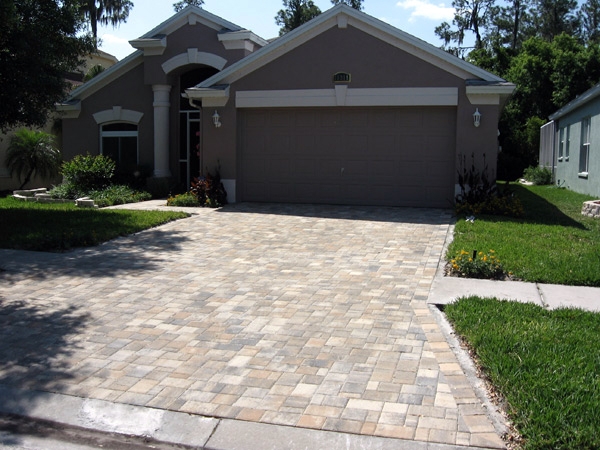Many people have a hard time choosing between pavers or stamped concrete for their new or renovated outdoor area. Every aspect of your home is an investment, even your exterior surroundings. Walkways, driveways and backyard patios all provide pathways that should be tied together to accent and enhance the overall personal and architectural style of your home. This article will give you a side by side comparison of stamped concrete and pavers. We’ll let you decide which one is better for your patio, driveway or walkway.
Stamped Concrete
Concrete has long been used as the mainstay for people having a driveway or patio done in home renovation. There are many advantages to stamped concrete. With stamped concrete, there are a variety of patterns and colors to choose from. Colors can also be hand blended on site in addition to the color that’s added to the concrete mix. You can imitate natural stone or segmented paving. A sealer is also usually added to protect the concrete from the elements and other chemicals.
 Unfortunately, when weather and time are involved in your concrete make over there is a probability of cracking. Cost of repairs and ongoing maintenance can get very expensive with stamped concrete because as the concrete cracks over time, one will have to have their concrete pattern matched in color and in pattern. This is nearly an impossible task when it comes to stamping concrete. The same replica of what originally was done in the first pouring of the concrete is not going to be the exact same in a repair. The sealer also needs to be reapplied every 2-3 years and the color of your stamped concrete will also fade over time.
Unfortunately, when weather and time are involved in your concrete make over there is a probability of cracking. Cost of repairs and ongoing maintenance can get very expensive with stamped concrete because as the concrete cracks over time, one will have to have their concrete pattern matched in color and in pattern. This is nearly an impossible task when it comes to stamping concrete. The same replica of what originally was done in the first pouring of the concrete is not going to be the exact same in a repair. The sealer also needs to be reapplied every 2-3 years and the color of your stamped concrete will also fade over time.
Pavers
Pavers or paving stones are individually made concrete units that are made to fit together and there are a variety of colors and patterns. These stones are some of the strongest materials made for paving a driveway, patio or walkway. They are manufactured to fit together in such a way that bends with the earth underneath rather than requiring repair because of cracking over time. The cost efficiency over time is very low since they do not need to be replaced. Pavers help when drainage is necessary for the area in question. Dealing with snow and weather related issues with pavers are typically a safer surface area for walking on. 
For pavers, joint sand needs to be topped off every couple of years unless a polymeric sand is used. Polymeric sand is a sand that binds and hardens the sand grains to each other and the pavers too. Weeds can eventually grow between the pavers unless a polymeric sand is used. When the polymeric sand hardens, weeds cannot grow in it. Dye lots can vary from pallet to pallet so if care is not taken when installing, a large area can appear blotchy. A skilled installer will know how to blend the pavers to eliminate this issue. Pavers can settle and move over time if they are not installed properly.
Pavers vs. Stamped Concrete
As you can see, there are pros and cons to both stamped concrete and pavers. Beautifying your outdoor space in an affordable and attractive way definitely requires some careful deliberation. When considering whether to go with stamped concrete or pavers, it’s important to keep the above mentioned factors in mind when stacking up your decision as both provide excellent choices that should last for a lifetime of enjoyment. One things for sure, with the durability and beauty of both of these patio materials it’s hard to go wrong.
For more information about stamped concrete and pavers, contact Increte of Houston here or call today for free advice and a free estimate!


Recent Comments